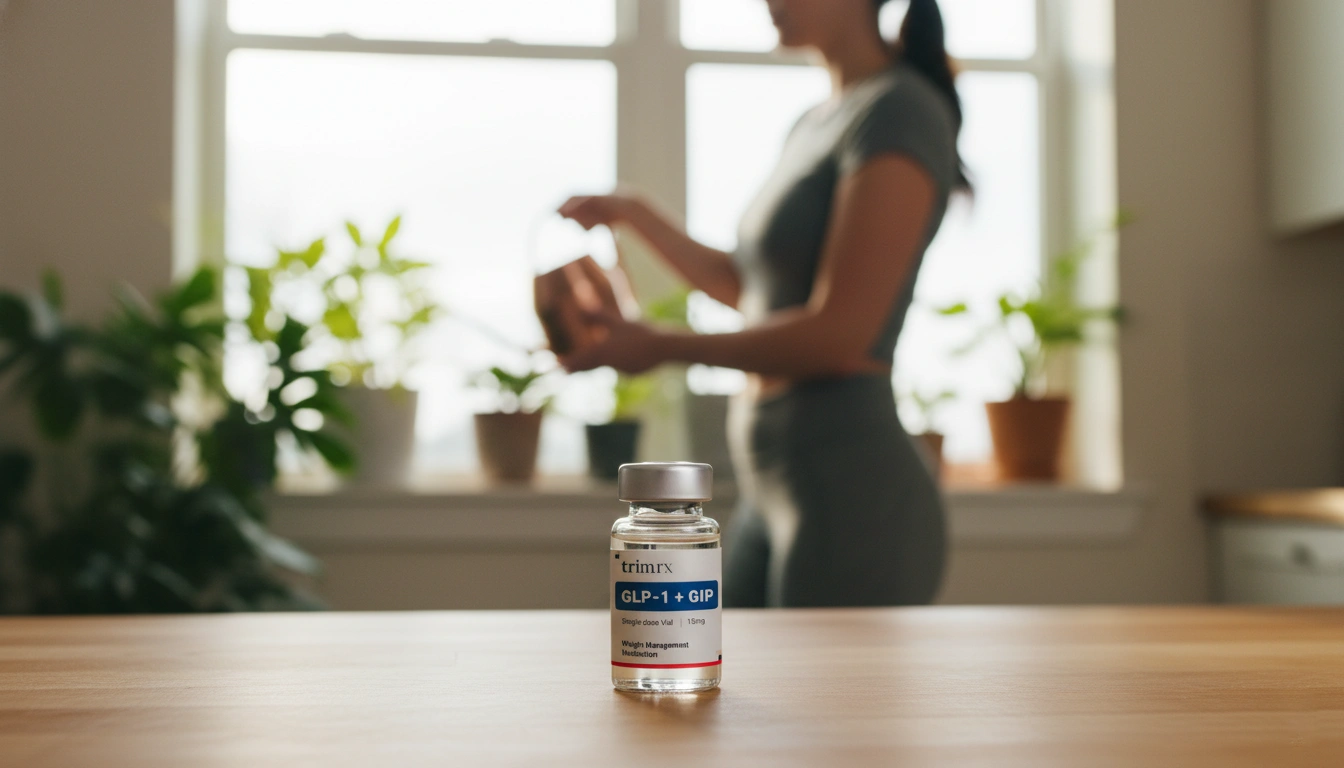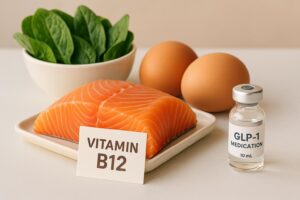How to Increase GLP-1 with Food: A Comprehensive Guide

Introduction
Did you know that a simple change in your diet could help regulate your appetite and improve your blood sugar levels? It’s true! The hormone glucagon-like peptide-1 (GLP-1) plays a crucial role in these processes, and recent studies show that we can enhance its production through the foods we eat. As we navigate through the complexities of weight management and metabolic health, understanding how to naturally increase GLP-1 levels can be a game-changer for many individuals striving for a healthier lifestyle.
GLP-1 is produced in the gut and is released during digestion, where it helps to stimulate insulin secretion, slow digestion, and promote feelings of fullness. In recent years, medications that mimic GLP-1 have gained popularity for their effectiveness in promoting weight loss and managing diabetes. However, many people are unaware that dietary choices can also significantly influence the levels of this hormone in our bodies.
In this blog post, we will explore how to effectively increase GLP-1 through food, shedding light on the specific nutrients and food groups that can enhance its secretion. We will provide insights into the mechanisms by which these foods work and discuss practical tips for incorporating them into your daily diet. By the end of this article, you’ll have a comprehensive understanding of how to harness the power of food to elevate your GLP-1 levels, supporting your journey towards better health and weight management.
Together, we’ll explore the importance of GLP-1, the types of food that can boost its production, and practical meal suggestions that prioritize this hormone. Let’s dive into this journey toward a healthier lifestyle, empowered by the knowledge of how our food choices can positively affect our body’s hormone regulation.
Understanding GLP-1: The Hormone Behind Appetite Regulation
GLP-1 is a multifaceted hormone produced in the intestines, primarily in response to food intake. It plays several critical roles in our body, particularly in regulating appetite and glucose metabolism. Here’s how GLP-1 functions:
-
Stimulates Insulin Secretion: After meals, GLP-1 signals the pancreas to release insulin, which helps lower blood sugar levels by facilitating the uptake of glucose into cells.
-
Inhibits Glucagon Release: Glucagon is another hormone that raises blood sugar levels. By suppressing glucagon, GLP-1 helps maintain balanced blood sugar levels.
-
Slows Gastric Emptying: GLP-1 slows the rate at which food leaves the stomach, promoting a feeling of fullness and reducing hunger.
-
Enhances Satiety Signals: By sending signals to the brain, GLP-1 helps regulate appetite and food intake, making us feel satisfied after eating.
-
Impacts Gut Motility: This hormone also influences how quickly food moves through the digestive system, contributing to overall digestive health.
Research indicates that individuals with obesity may have altered GLP-1 responses, making it crucial to explore dietary approaches that can enhance its production naturally.
As we proceed, we’ll examine the types of foods known to stimulate GLP-1 release and how they can be incorporated into a balanced diet.
Foods That Naturally Increase GLP-1 Levels
1. High-Fiber Foods
Fiber is a key player in the promotion of GLP-1 secretion. It acts as a substrate for fermentation by gut bacteria, producing short-chain fatty acids (SCFAs) that stimulate GLP-1 release. Here are some fiber-rich foods to consider:
-
Whole Grains: Foods like oats, barley, and quinoa are excellent sources of soluble fiber, which can enhance GLP-1 levels. Including these in your breakfast or as part of a grain bowl can significantly boost your fiber intake.
-
Fruits: Apples, pears, and citrus fruits contain both soluble and insoluble fiber. These fruits are not only delicious but also contribute to increased GLP-1 production.
-
Vegetables: Leafy greens, Brussels sprouts, and carrots are packed with fiber and essential nutrients. They can be easily incorporated into salads, stir-fries, or as side dishes.
2. Healthy Fats
Incorporating healthy fats into your diet can also promote GLP-1 secretion. Here are some sources of beneficial fats:
-
Avocado: Rich in monounsaturated fats and fiber, avocados have been shown to increase GLP-1 levels. Enjoy them in salads, smoothies, or as spreads.
-
Nuts: Almonds, walnuts, and pistachios are not only filling but also provide healthy fats that can enhance GLP-1 secretion. Snacking on a handful of nuts can be a great way to incorporate these into your diet.
-
Olive Oil: Extra virgin olive oil is a staple in the Mediterranean diet and is associated with numerous health benefits, including increased GLP-1 levels. Use it as a dressing or for cooking.
3. Protein Sources
Protein is another vital macronutrient that can stimulate GLP-1 production. Consider including these protein sources in your meals:
-
Eggs: Eggs are a versatile and nutritious option that can help increase GLP-1 levels. Studies have shown that meals high in protein can lead to greater GLP-1 secretion, making eggs an excellent breakfast choice.
-
Lean Meats: Poultry and fish are great sources of lean protein that can contribute to GLP-1 release. Incorporate chicken, turkey, or salmon into your meal planning for a satiating option.
-
Legumes: Beans, lentils, and chickpeas are not only rich in protein but also high in fiber, making them perfect for enhancing GLP-1 levels. They can be used in soups, salads, or as a meat substitute in various dishes.
4. Fermentable Foods
Fermentable fibers are particularly effective at increasing GLP-1 due to their ability to be broken down by gut bacteria into SCFAs. Include these foods in your diet:
-
Chia Seeds: Rich in fiber and omega-3 fatty acids, chia seeds can be added to smoothies, yogurt, or oatmeal to enhance GLP-1 secretion.
-
Fermented Foods: Foods like yogurt, kefir, and sauerkraut contain probiotics that can support gut health and may also improve GLP-1 levels. Incorporating these into your meals can provide additional health benefits.
-
Beta-Glucan: Found in oats and barley, beta-glucan is a type of soluble fiber that has been linked to increased GLP-1 secretion. Make oatmeal, add barley to soups, or enjoy whole grain breads.
5. Timing and Eating Habits
In addition to the types of foods you consume, the timing of meals and your eating habits can also affect GLP-1 levels. Here are some considerations:
-
Mindful Eating: Taking the time to eat slowly and savor your meals can enhance GLP-1 secretion. Consider setting aside distractions during mealtime to focus on your food.
-
Meal Composition: Eating protein-rich foods first can stimulate GLP-1 release more effectively. Try starting your meals with a protein source before moving on to carbohydrates.
-
Meal Timing: Some studies suggest that consuming most of your calories earlier in the day rather than later can positively impact GLP-1 levels. Consider structuring your meals to focus on a hearty breakfast and lunch.
Sample Meal Plan to Increase GLP-1
To put this knowledge into practice, here’s a sample meal plan that incorporates foods known to boost GLP-1 levels:
Breakfast
- Scrambled eggs with spinach and tomatoes, served with avocado slices
- A bowl of steel-cut oatmeal topped with chia seeds and fresh berries
Lunch
- A quinoa salad with mixed greens, chickpeas, cucumber, and a lemon-olive oil dressing
- A wrap made with whole grain tortilla, turkey, hummus, and assorted vegetables
Dinner
- Grilled salmon served with a side of roasted Brussels sprouts and quinoa
- A stir-fry with tofu, mixed vegetables, and brown rice, flavored with ginger and garlic
Snacks
- A handful of mixed nuts or a piece of fruit like an apple or pear
- Greek yogurt topped with honey and flaxseeds
Conclusion
Increasing GLP-1 levels through food is an empowering approach to managing hunger, blood sugar, and overall metabolic health. By incorporating high-fiber foods, healthy fats, lean proteins, and fermentable fibers into your diet, you can naturally enhance the production of this beneficial hormone. Additionally, being mindful of your eating habits and meal timing can further optimize your body’s GLP-1 response.
At TrimRx, we believe in the power of personalized, medically supervised weight loss solutions that align with your unique needs and goals. As you explore ways to boost GLP-1 naturally, consider taking our free assessment quiz to discover how our specialized weight loss programs can support you on your journey. Together, we can create a sustainable path to health that empowers you to achieve your desired outcomes.
FAQ
What is GLP-1 and why is it important?
A1: GLP-1 is a hormone produced in the gut that plays a vital role in regulating appetite and blood sugar levels. It stimulates insulin secretion, inhibits glucagon release, and promotes a feeling of fullness.
What foods can help increase GLP-1 levels?
A2: Foods high in fiber (like whole grains, fruits, and vegetables), healthy fats (such as avocados and nuts), and lean proteins (like eggs and chicken) are known to enhance GLP-1 production.
How does fiber affect GLP-1 secretion?
A3: Fiber is fermented by gut bacteria into short-chain fatty acids, which stimulate the release of GLP-1. Soluble fiber, in particular, is effective at promoting this hormone’s secretion.
How can meal timing influence GLP-1 levels?
A4: Eating meals earlier in the day and consuming protein-rich foods first can enhance GLP-1 responses. Mindful eating and savoring your meals may also support better hormone regulation.
Can I achieve the same effects with supplements?
A5: While supplements may have some benefits, dietary sources of nutrients are generally more effective for stimulating GLP-1 and supporting overall health. Focus on incorporating whole foods into your diet for the best results.

Transforming Lives, One Step at a Time
Keep reading
Vitamin B12 and GLP-1 Medications: What to Know
GLP-1 medications can lower B12 absorption and intake; learn symptoms, food sources, supplement options, and how to monitor levels.
Semaglutide Injection Site Reactions: What To Know
Learn why semaglutide injections can cause redness, swelling or nodules, how to prevent and treat them, and when to seek medical care.
TrimRx vs Friday’s
Compare TrimRx and Friday’s telehealth GLP-1 weight-loss programs: pricing, medical support, coaching, delivery, and which fits your needs.



